The Lenovo ThinkPad A285 (12.5-Inch) Review: Ryzen Pro Gets Down to Business
by Brett Howse on December 18, 2018 8:00 AM EST- Posted in
- Laptops
- AMD
- Lenovo
- ThinkPad
- Vega
- Ryzen
- Ryzen PRO
- Ryzen Mobile
- Vega Mobile
Display Analysis
Lenovo's default panel in the ThinkPad A285 is a 1366x768 TN panel, while a 1920x1080 IPS panel is offered as an upgrade option. I find it hard to believe that anyone really wants the TN, but clearly people are still buying it to save a few dollars, especially when they buy in bulk. Some day laptops that cost this much won’t ship with TN displays, but that day is not today. Luckily the review unit is the IPS panel, which also offers touch.
Unlike most device makers, Lenovo still offers a matte coating on their touch displays, which you can see in the image below.
The matte coating blurs the pixels, making it not quite as crisp as a clear coating, but in the office, matte still has a lot of support. It generally helps with lighting, although a quality anti-reflective coating can help as well.
While not high-DPI by most PC standards, the 12.5-inch panel still offers a respectable 176 pixels per inch. There is always a trade-off between resolution and battery life, although TFTs like LTPS and IGZO can help claw back some of the extra power drain.
To measure the display accuracy and characteristics, we use SpectraCal’s CalMAN software suite, along with an X-Rite i1 DisplayPro colorimeter for brightness and contrast readings, and an X-Rite i1Pro2 spectrophotometer for color accuracy testing.
Brightness and Contrast
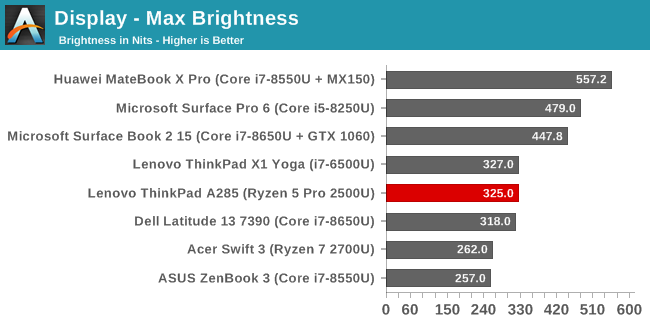
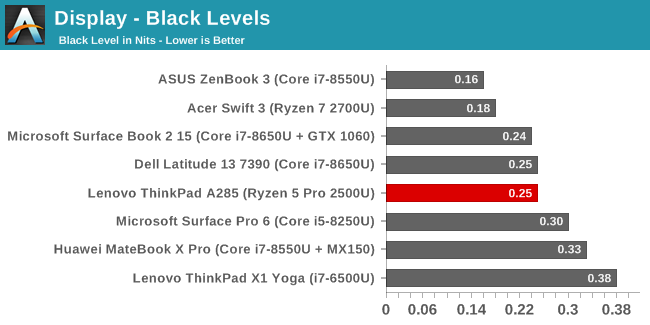
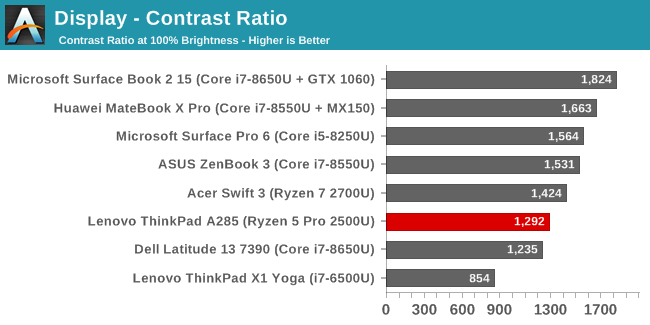
The ThinkPad A285 is rated for 300 nits, and manages to achieve a bit over that at 325. It isn’t the brightest device, but the anti-glare coating should help outdoors. The black levels are quite good though, leading to a decent contrast of almost 1300:1. The brightness also goes down to an impressive 3.4 nits.
Grayscale
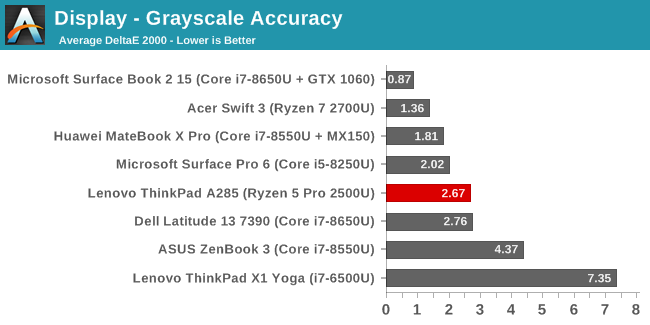
The laptop has a good average grayscale result, although there are definite issues when looking past the averages. The red drops off quite a bit before 100% white, while the blue is too high, leading to a fairly cool display temperature of 7400. The gamma is also too high for most of the range, but then falls off as the brightness gets close to 100%. It isn’t terrible, but it’s pretty average for an IPS panel and clearly there’s no calibration here.
Gamut
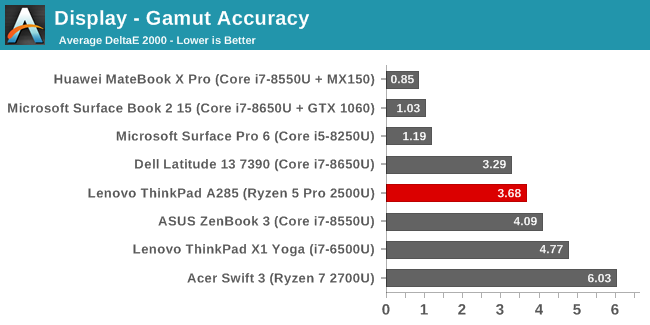
When looking at the sRGB gamut accuracy, we can see that blue is well beyond the correct amount, which pulls magenta off as well. Red is not quite able to hit 100% sRGB, and green is close but slightly out of line.
Saturation
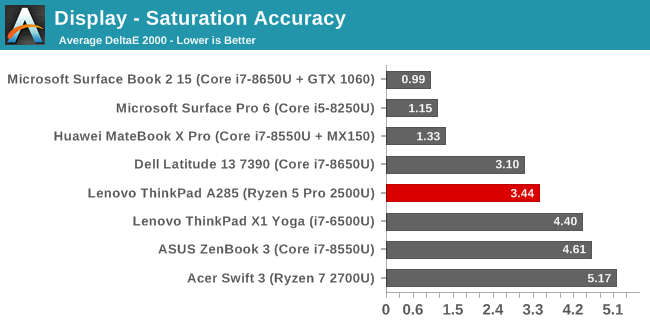
Looking at the 4-bit spaced saturation sweep, you can see that there’s a consistent error level which increases linearly to the 100% levels. None of the colors are in their range, although the average error level isn’t too bad since it’s much closer near the black end of the scale.
Gretag Macbeth
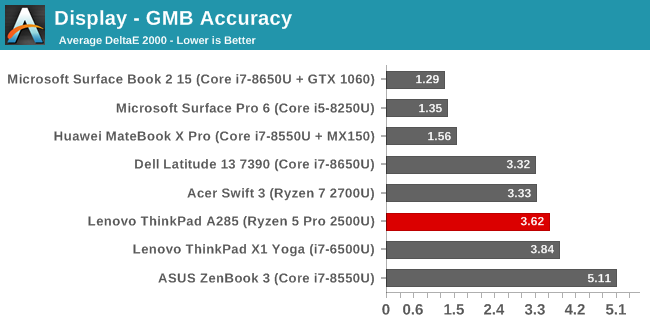
The Gretag Macbeth colorchecker tests various colors, and not just the primary and secondary values. It also includes the important skin tones. As you can see in the graph, there is quite a bit of error on some colors, and others are much closer to where they should be.
Relative Result
This image shows the requested color on the bottom, and the relative result on the top that the display output. The result is relative due to errors in your display, but it does make it fairly clear as to the color drawbacks with this display.
Display Conclusion
The TN option would be better for everyone if it was just gone, so lets just pretend it is. The IPS is very much just a middle of the road display. It offers a good choice in resolution, but it’s not a high-DPI panel. The IPS display offers good off-axis viewing and good contrast levels, but it’s not the brightest around. The color accuracy isn’t great, but it isn’t terrible either. If you’re just doing office tasks, then there’s likely no issues here regardless, and offering the matte coating on a touch display is something that most office workers will appreciate.

















72 Comments
View All Comments
MonkeyPaw - Tuesday, December 18, 2018 - link
I agree. I have a hihg-DPI Lenovo that I dock, and when I undock, I get blurry fonts in Office because my desktop monitor is old-DPI. I’d have to log out and back in each time I docked and undocked, which is not a convenient thing to do going from my desk to a 1 hour meeting and back. We run Windows 10, but we stay a few versions back for testing/stability (I assume).GreenReaper - Tuesday, December 18, 2018 - link
They've had the TN 1366x768 screens for years - I'm using one now (albeit with several other better ones plugged in). It works, but it's pretty bad colour-wise and the low resolution is why sites still need to be designed for such resolutions: they're still sold, new.Spunjji - Tuesday, December 18, 2018 - link
Why do OEMs keep putting capable processors in a chassis with terrible thermal management? If the CPU can't even hit its base frequency under load and yet is *below TDP* then something is very badly wrong with the design.That plus the terrible WiFi seems like unnecessary own-goals. It's a shame. AMD have a lot of work to do to catch up on idle power draw, but they're never going to get the investment necessary if their processors only ever get crammed into half-baked products.
johnny_boy - Tuesday, December 18, 2018 - link
A shame about the idle power draw coupled with a small battery. The screen also sucks but at least it can be upgraded. I was surprised at the performance difference of the iGPUs in the 2500u and 2700u, especially since the CPU tests often ran worse on the 2700u. I wish there were more 2700u laptops available, because that is the sort of iGPU performance I am looking for. And with pretty darn good linux driver support, Ryzen is very enticing (for someone like me).mczak - Tuesday, December 18, 2018 - link
There is just about zero GPU performance difference between a 2700U with Vega 10 and a 2500U with Vega 8 (ok not quite zero but it's tiny). Just about any significant difference between these two comes down to the actual implementation, that is configured TDP, thermal limits, cooling.And apparently Lenovo blew this completely on this notebook.
sfwineguy - Tuesday, December 18, 2018 - link
Sorry to miss something obvious here, but why (per the graphs) did the 2700u underperform the 2500u in some of the CPU tests? Doesn't that confound expectations? Is the 2700u reviewed in another piece that explains how its little brother beats it up in some tests?MonkeyPaw - Tuesday, December 18, 2018 - link
Probably better cooling in the Lenovo, allowing the CPU to stay boosted higher and more often.YukaKun - Tuesday, December 18, 2018 - link
"It would be nice to see a 16 GB offering, but for office tasks, 8 GB should suffice."Oof... That couldn't be more wrong, my dear Brett. The amount of bloatware *cough*McAffee*cough* is just bonkers. 8GB is the *minimum* an enterprise laptop needs nowadays to run a bit less like a hog. For development, 16GB has been the minimum for years (~2013) and now it's moving to 32GB per developer laptop.
Cheers!
HStewart - Tuesday, December 18, 2018 - link
As a developer unless you are using a lot of Virtual Machines, I don't see much of need to go more 16GB of RAM - However, if you a 3D Graphics Artist, I would believe it will be useful for large scene. most of my machines have 16G. My actual work machine for development has 12G but it older 3rd generation i7.A5 - Tuesday, December 18, 2018 - link
Meh, it's not just VMs.GCC will use as much RAM as you'll let it if your project is of sufficient size, not to mention web browsers, Outlook, etc.